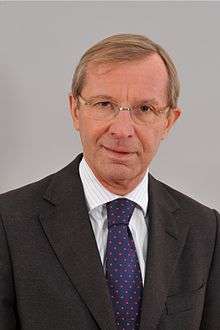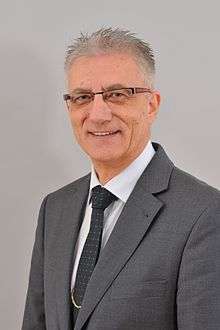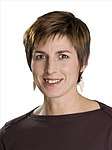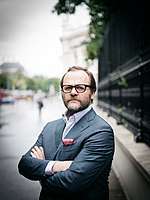2018 Salzburg state election
The 2018 Salzburg state election was held on 22 April 2018 to elect the members of the Landtag of Salzburg.
| ||||||||||||||||||||||||||||||||||||||||||||||||||||||||||||||||||||
All 36 seats in the Landtag of Salzburg 19 seats needed for a majority | ||||||||||||||||||||||||||||||||||||||||||||||||||||||||||||||||||||
|---|---|---|---|---|---|---|---|---|---|---|---|---|---|---|---|---|---|---|---|---|---|---|---|---|---|---|---|---|---|---|---|---|---|---|---|---|---|---|---|---|---|---|---|---|---|---|---|---|---|---|---|---|---|---|---|---|---|---|---|---|---|---|---|---|---|---|---|---|
| Turnout | 253,396 (65.0%) | |||||||||||||||||||||||||||||||||||||||||||||||||||||||||||||||||||
| ||||||||||||||||||||||||||||||||||||||||||||||||||||||||||||||||||||
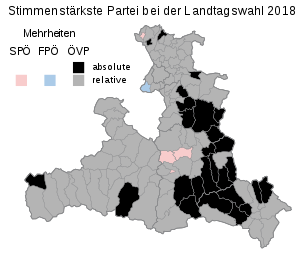 Results by municipality. The lighter shade indicates a plurality; the darker shade indicates a majority. | ||||||||||||||||||||||||||||||||||||||||||||||||||||||||||||||||||||
| ||||||||||||||||||||||||||||||||||||||||||||||||||||||||||||||||||||
The conservative Austrian People's Party (ÖVP) placed first, taking 37.8% of votes on a swing of almost nine percentage points, a decisive lead over the second-placed Social Democratic Party of Austria (SPÖ) which slipped four points, finishing on just over 20%. The Freedom Party of Austria (FPÖ) made small gains. The Greens were the main loser of the election; their voteshare fell by over half from 2013. NEOS – The New Austria (NEOS) contested their first state election in Salzburg, debuting at 7.3%. Team Stronach, which had won 8.3% in the previous election, did not compete.[1]
The previous government coalition of the ÖVP, Greens, and Team Stronach now lacked a majority due to the absence of Team Stronach. After negotiations, NEOS agreed to join a coalition with the ÖVP and Greens, marking the first time NEOS had participated in a state government in Austria.[2]
Background
After the 2013 election, the SPÖ government was replaced by a coalition of the ÖVP, Greens, and Team Stronach. In November 2015, Hans Mayr, the only member of the state government from Team Stronach, left the party, but continued to serve in government as an independent. In 2016 he founded his own party, the Salzburg Citizens' Community (SBG), with the intention of running in the 2018 state election.[3]
In June 2015, conflicts arose between the federal FPÖ and the party's Salzburg branch, culminating in the expulsion of former regional chairmen Strache Schnell and Rupert Doppler from the party. They subsequently founded the Free Party Salzburg (FPS), which was joined by five of the FPÖ's six Landtag deputies. They sought to run in the 2018 election.[4][5]
Electoral system
The 36 seats of the Landtag of Salzburg are elected via open list proportional representation in a two-step process. The seats are distributed between six multi-member constituencies. For parties to receive any representation in the Landtag, they must either win at least one seat in a constituency directly, or clear a 5 percent state-wide electoral threshold. Seats are distributed in constituencies according to the Hare quota, with any remaining seats allocated using the D'Hondt method at the state level, to ensure overall proportionality between a party's vote share and its share of seats.[6]
Contesting parties
The table below lists parties represented in the previous Landtag.
| Name | Ideology | Leader | 2013 result | |||
|---|---|---|---|---|---|---|
| Votes (%) | Seats | |||||
| ÖVP | Austrian People's Party Österreichische Volkspartei |
Christian democracy | Wilfried Haslauer Jr. | 29.0% | 11 / 36 | |
| SPÖ | Social Democratic Party of Austria Sozialdemokratische Partei Österreichs |
Social democracy | Walter Steidl | 23.8% | 9 / 36 | |
| GRÜNE | The Greens – The Green Alternative Die Grünen – Die Grüne Alternative |
Green politics | Astrid Rössler | 20.2% | 7 / 36 | |
| FPÖ | Freedom Party of Austria Freiheitliche Partei Österreichs |
Right-wing populism Euroscepticism |
Marlene Svazek | 17.0% | 6 / 36 | |
Team Stronach, which contested the previous election and won 8.3% of votes and three seats did not contest the 2018 election.
In addition to the parties already represented in the Landtag, four parties collected enough signatures to be placed on the ballot.
- NEOS – The New Austria (NEOS)
- Free Party Salzburg (FPS)
- List Hans Mayr – Salzburg Citizens' Community (MAYR)
- KPÖ Plus (KPÖ) – on the ballot only in Salzburg City and Salzburg Surrounds
- Christian Party of Austria (CPÖ) – on the ballot only in Salzburg Surrounds
Results
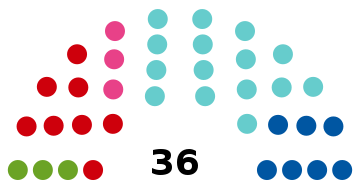 | ||||||
| Party | Votes | % | +/− | Seats | +/− | |
|---|---|---|---|---|---|---|
| Austrian People's Party (ÖVP) | 94,642 | 37.78 | +8.77 | 15 | +4 | |
| Social Democratic Party of Austria (SPÖ) | 50,175 | 20.03 | –3.80 | 8 | –1 | |
| Freedom Party of Austria (FPÖ) | 47,194 | 18.84 | +1.81 | 7 | +1 | |
| The Greens – The Green Alternative (GRÜNE) | 23,337 | 9.31 | –10.87 | 3 | –4 | |
| NEOS – The New Austria (NEOS) | 18,225 | 7.27 | +7.27 | 3 | +3 | |
| Free Party Salzburg (FPS) | 11,386 | 4.54 | New | 0 | New | |
| List Hans Mayr – Salzburg Citizens' Community (MAYR) | 4,385 | 1.75 | New | 0 | New | |
| KPÖ Plus (KPÖ) | 1,014 | 0.40 | +0.07 | 0 | ±0 | |
| Christian Party of Austria (CPÖ) | 181 | 0.07 | +0.07 | 0 | ±0 | |
| Invalid/blank votes | 2,857 | – | – | – | – | |
| Total | 253,396 | 100 | – | 36 | 0 | |
| Registered voters/turnout | 390,091 | 64.96 | –6.00 | – | – | |
| Source: Salzburg State Government | ||||||
Results by constituency
| Constituency | ÖVP | SPÖ | FPÖ | Grüne | NEOS | FPS | Others | Total seats |
Turnout | ||||||
|---|---|---|---|---|---|---|---|---|---|---|---|---|---|---|---|
| % | S | % | S | % | S | % | S | % | S | % | S | % | |||
| Salzburg City | 29.9 | 2 | 23.2 | 2 | 15.9 | 1 | 15.8 | 1 | 9.2 | 3.5 | 2.4 | 6 | 57.3 | ||
| Hallein | 40.1 | 1 | 20.4 | 18.0 | 9.2 | 7.1 | 3.9 | 1.4 | 1 | 68.3 | |||||
| Salzburg Surrounds | 39.5 | 3 | 16.8 | 1 | 20.6 | 2 | 9.5 | 8.2 | 3.2 | 2.0 | 6 | 67.4 | |||
| St. Johann im Pongau | 39.9 | 1 | 21.0 | 1 | 20.8 | 1 | 5.0 | 5.5 | 4.2 | 3.7 | 3 | 68.6 | |||
| Tamsweg | 48.7 | 17.4 | 21.1 | 4.2 | 4.1 | 3.4 | 1.1 | 0 | 71.4 | ||||||
| Zell am See | 38.5 | 2 | 21.1 | 1 | 17.7 | 1 | 5.7 | 5.5 | 9.6 | 1.8 | 4 | 65.1 | |||
| Remaining seats | 6 | 3 | 2 | 2 | 3 | 0 | 16 | ||||||||
| Total | 37.8 | 15 | 20.0 | 8 | 18.8 | 7 | 9.3 | 3 | 7.3 | 3 | 4.5 | 0 | 2.2 | 36 | 65.0 |
| Source: Salzburg State Government | |||||||||||||||
Maps
 Results by party
Results by party
Aftermath
On 23 April, Astrid Rössler announced her resignation as Greens leader, but remained in office on an interim basis and to participate in coalitions negotiations.[7]
The ÖVP initiated exploratory talks with all parties in the Landtag. On 2 May, the state ÖVP executive voted to begin negotiate with the Greens and NEOS for a governing coalition. Haslauer described this arrangement as "a political alliance of the centre"; however, ÖVP federal Chancellor Sebastian Kurz advocated a coalition with the FPÖ.[8][9] On 25 May, coalition negotiations between the three parties were finalised, and the cabinet was presented. It was dubbed the "Dirndl coalition", after a traditional dress which is coloured similarly to the parties involved (black, green, and pink). The government was sworn in on 13 June.[2]
References
- "Landtag election on 22 April 2018". Salzburg State Government.
- ""Salzburg election: "Dirndl coalition" is certain"". Die Presse. 25 May 2018.
- "Ex-Stronach State Councillor Mayr founds Salzburg Citizens' Association". Der Standard. 20 April 2016.
- "Eight FPÖ expulsions fixed". ORF. 16 June 2015.
- "FPÖ-Salzburg: Court prohibits the name "Freiheitliche"". Die Presse. 31 July 2015.
- "Election results". Salzburg State Government.
- "Green debacle in Salzburg - Rössler goes, but remains for the time being". Salzburger Nachrichten. 23 April 2018.
- "Coalition question: Haslauer has to show his colours". Salzburger Nachrichten. 2 May 2018.
- "New Salzburg state government: Haslauer wants "Alliance of the Centre"". Salzburger Nachrichten. 3 May 2018.
